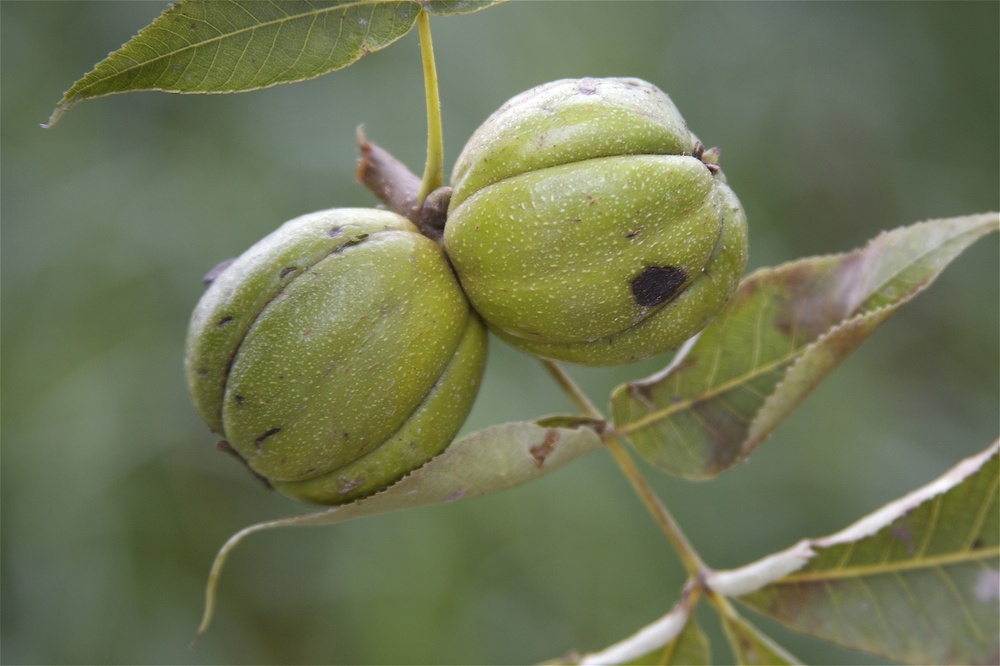Carya ovata
Witte bitternoot / Shellbark hickory
Juglandaceae (Okkernootfamilie)
Edible plant part (2)
Nuts,
sap
Read 'form of consumption' for safe preparation methods
Toxic plant part (1)
None
Shellbark hickory belongs to the small trees-large shrubs in the food forest. In the process of ecological succession it is a late species. The growth rate is slow. Fully grown the plant has an average height of 15 to 35 meter. and a width of 10 to 25 meter.
The foliage (or leaf cover) is half-open. The Shellbark hickory is decidious. It buds in may.
This species forms a taproot deep root system. This species is non spreading in the food forest. Shellbark hickory is no nitrogen fixer.
 foto: Dan Mullen, https://www.flickr.com/photos/8583446@N05/3961305922
foto: Dan Mullen, https://www.flickr.com/photos/8583446@N05/3961305922
 foto: Dan Mullen, https://www.flickr.com/photos/8583446@N05/3961305922
foto: Dan Mullen, https://www.flickr.com/photos/8583446@N05/3961305922
 foto: Plant Image Library, https://www.flickr.com/photos/138014579@N08/27074521022
foto: Plant Image Library, https://www.flickr.com/photos/138014579@N08/27074521022
 foto: KATHERINE WAGNER-REISS, https://commons.wikimedia.org/wiki/File:Carya_ovata%E2%80%94compound_leaf_and_fruit.jpg
foto: KATHERINE WAGNER-REISS, https://commons.wikimedia.org/wiki/File:Carya_ovata%E2%80%94compound_leaf_and_fruit.jpg
Growth factors
- Frost (whole plant)
-
very strong frostcold frostmild frostlight frostno frost
- Frost (flowers)
-
very strong frostcold frostmild frostlight frostno frost
- Light
-
full sunlight shadehalf shadefairly deep shadedeep shade
- Wind
-
strong sea windstrong windsome windshelteredvery sheltered
- Soil texture
-
sandloamlight clayheavy claypeat
- Soil moisture
-
inundationwetmoistdrydrought
- Groundwater level
-
very lowlowmediumhighvery high
- Soil acidity
-
very acidacidneutralalkalinevery alkaline
- Soil fertility
-
very richrichaveragepoorvery poor
Flowering and pollination
- Flowering period (peak)
- early may, mid may, end of may
- Flowering period (length)
- several weeks
- Pollination vector
- wind
- Plant reproductive fertility
- partially self-fertile, self sterile, varies per cultivar
Life Span and Plant Health
Disease susceptibility
very resistantMain serious pests and diseases
yet unknownHarvest and Consumption
Nuts
Sap
- Harvest location edible part
- Ground layer
- Harvesting period - start
- Early october, mid october, end of october
- Harvesting period - length
- Several weeks
- Harvesting period - uniformity
- Medium
- Suitable harvesting methods
- Hand, simple tool
- Form of consumption
- Fresh, processed
- Natural storability
- Year
- Suitable markets
- Niche
- Productive life span - start (year) - minimum
- 12
- Productive life span - peak (year) - minimum
- 30
- Form of consumption
- Fresh
- Natural storability
- Year
- Productive life span - start (year) - minimum
- 10
- Productive life span - start (year) - maximum
- 12









































